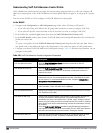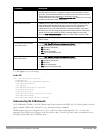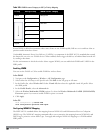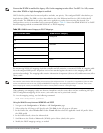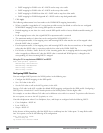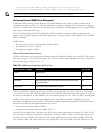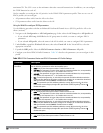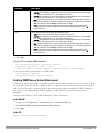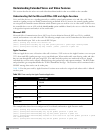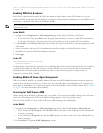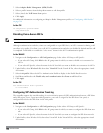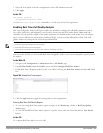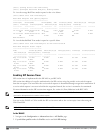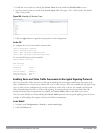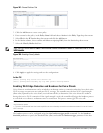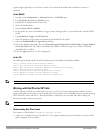
703 | VoiceandVideo DellPowerConnectW-SeriesArubaOS6.2 | User Guide
Understanding Extended Voice and Video Features
This section describes the other voice and video-related functionalities that are available on the controller.
Understanding QoS for Microsoft Office OCS and Apple Facetime
Voice and video devices use a signaling protocol to establish, control, and terminate voice and video calls. These
control or signaling sessions are usually permitted using pre-defined ACLs. If, however, the control signaling packets
are encrypted, the controller cannot determine which dynamic ports are used for voice or video traffic. In these cases,
the controller has to use an ACL with the classify-media option enabled to identify the voice or video flow based on
a deep packet inspection and analysis of the actual traffic.
Microsoft OCS
Microsoft Office Communications Server (OCS) uses Session Initiation Protocol (SIP) over TLS to establish,
control, and terminate voice and video calls. The following example creates an ACL named ocs for Microsoft OCS
traffic that identifies port 5061 as the reserved SIP-TLS port.
(host) (config) #ip access-list session ocs
(host) (config-sess-ocs)#any any tcp 5061 permit position 1 queue high classify-media
(host) (config-sess-ocs)#any any udp 1-65535 permit position 2 queue low
Apple Facetime
When an Apple device starts a Facetime video call, it initiates a TCP session to the Apple Facetime server over port
5223, then sends SIP signaling messages over a non-default port. When media traffic starts flowing, audio and video
data are sent through that same port using RTP. (The audio and video packets are interleaved in the air, though
individual the sessions can be uniquely identified using their payload type and sequence numbers.) The RTP header
and payload also get encapsulated under the TURN ChannelData Messages. The Facetime call is terminated with a
SIP BYE message that can be sent by either party.
Table 304 lists the ports used by Apple Facetime. Facetime users need to be assigned a role where traffic is allowed
on these ports
Port Packet Type
53 TCP/UDP
443 TCP
3478-3497 UDP
5223 TCP
16384-16387 UDP
16393-16402 UDP
Table 304:
Ports used by the Apple Facetime Application
The example below shows how to configure an ACL to identify and monitor Apple Facetime traffic.
(host) (config) #ip access-list session facetime
(host) (config-sess-facetime)#any any tcp 80 permit position 1 queue low
(host) (config-sess-facetime)#any any tcp 443 permit position 2 queue low
(host) (config-sess-facetime)#any network 17.0.0.0 255.0.0.0 tcp 5223 permit position 3 queue
low classify-media
(host) (config-sess-facetime)#any any UDP 80 permit position 4 queue low



